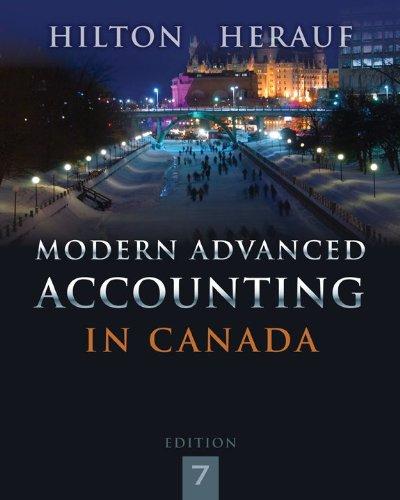Andrew Ltd. is a large private company owned by the Andrew family. It operates a number of
Question:
You have identified four areas where Andrew's accounting policies could have differences between ASPE and IFRSs. Where choices exist under ASPE, Andrew has adopted allowable policies that maximize net income and shareholders' equity. You have identified four areas where Andrew's accounting policies could have differences between ASPE and IFRSs. Where choices exist under ASPE, Andrew has adopted allowable policies that maximize net income and shareholders' equity. The controller at Andrew provides the following information for the four areas:
Intangible Assets
Andrew owns a number of Intangible Assets and depreciates them over their useful lives, ranging from 3 to 7 years. The patents are checked for impairment on an annual basis. Relevant values pertaining to these patents were as follows:
-2.png)
Property, Plant, and Equipment
Andrew acquired equipment at the beginning of Year 4 at a cost of $1,250. The equipment has an estimated useful life of 10 years, an estimated residual value of $50, and is being depreciated on a straight-line basis. At the beginning of Year 6, the equipment was appraised and determined to have a fair value of $1,090; its estimated useful life and residual value did not change. The company could adopt the revaluation option in IAS 16 to periodically revalue the equipment at fair value subsequent to acquisition.
Research and Development Costs
Andrew incurred research and development costs of $200 in Year 6. Of this amount, 40% related to development activities subsequent to the point at which criteria indicating that the creation of an intangible asset had been met. As of year-end, development of the new product had not been completed.
Redeemable Preferred Shares
In Year 4, Andrew issued redeemable preferred shares to the original founders of the company in exchange for their previously held common shares as part of a tax planning arrangement. The preferred shares were assigned a value of $100 and have been reported in shareholders' equity in the preliminary financial statements. The common shares, which had a carrying amount of $100, were cancelled. The preferred shares would be classified as long-term debt under IFRSs and would need to be reported at their redemption value of $1,800. The CEO is concerned about the impact of converting Andrew's financial statements from ASPE to IFRSs.
Required:
(a) Calculate the two ratios first using ASPE and then using IFRSs. Prepare a schedule showing any adjustments to the numerator and denominator for these ratios. Ignore income taxes.
(b) Explain whether Andrew's solvency and profitability look better or worse under IFRSs after considering the combined impact of the four areas of difference.
An intangible asset is a resource controlled by an entity without physical substance. Unlike other assets, an intangible asset has no physical existence and you cannot touch it.Types of Intangible Assets and ExamplesSome examples are patented... Financial Statements
Financial statements are the standardized formats to present the financial information related to a business or an organization for its users. Financial statements contain the historical information as well as current period’s financial... Solvency
Solvency means the ability of a business to fulfill its non-current financial liabilities. Often you have heard that the company X went insolvent, this means that the company X is no longer able to settle its noncurrent financial...
Step by Step Answer:

Modern Advanced Accounting In Canada
ISBN: 9781259066481
7th Edition
Authors: Hilton Murray, Herauf Darrell





